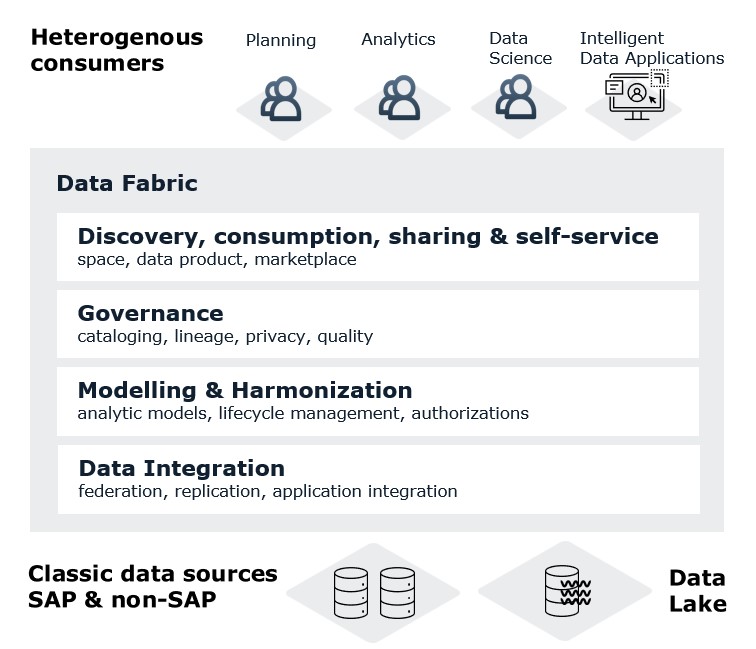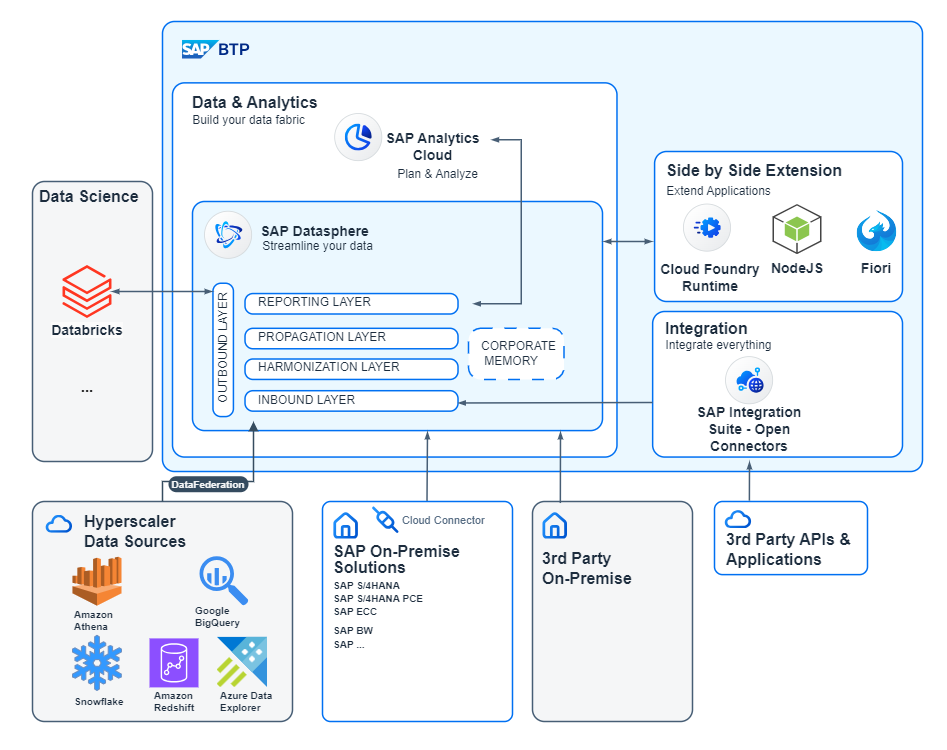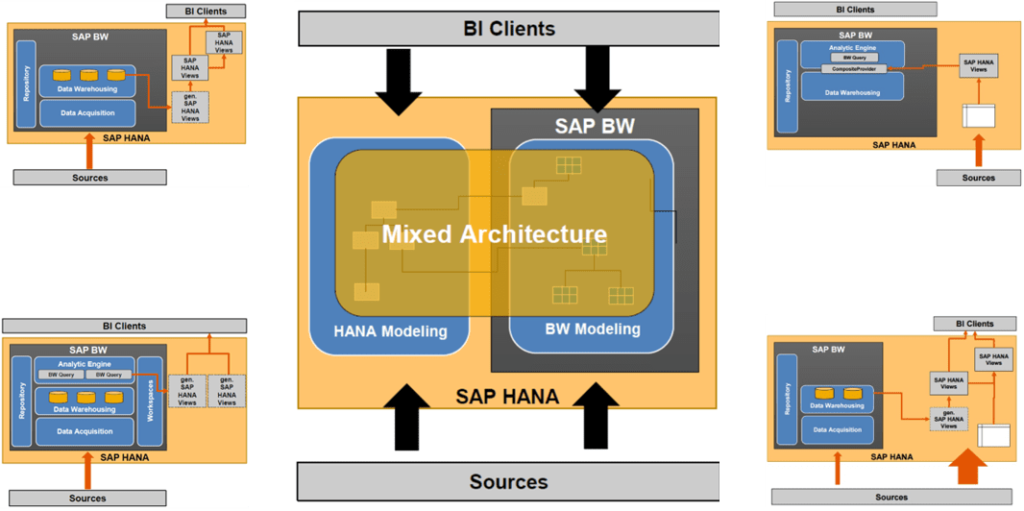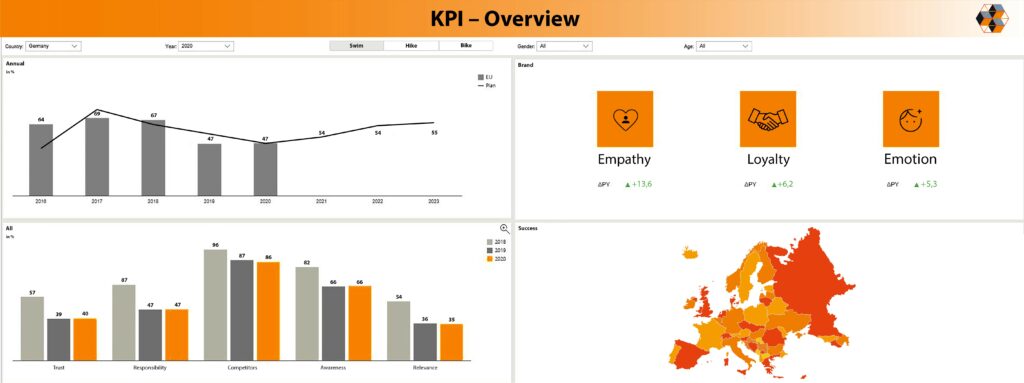SAP Analytics
Quick and meaningful insights with SAP Analytics. The SAP Business Technology Platform contains tools in the areas of Business Intelligence, Data Warehousing and Corporate Planning. In addition to the classic topics such as Business Intelligence, which deals more with past-related data, companies can also use SAP Analytics to determine possible future business developments.
How Companies make the Most of their Opportunities
80% of the effort involved in a typical analytics project is spent on restoring the context that has been lost. At the same time, the amount of data worldwide will grow by around 27% per year in the future. This development will have an enormous impact on companies, but at the same time it will also offer them great opportunities. However, with SAP Analytics and the in-memory technology of SAP HANA, you are well prepared. We support you in the changeover to these technologies and are very familiar with the interaction of these two SAP technologies.
BIG.Cube supports us safely and comprehensively in small as well as large, complex projects due to its high level of professional and technical understanding.
Interplay between Expertise and Technology
For us, the combination of in-depth professional know-how and technological expertise is very important. We have also aligned our approach accordingly: our team of business analysts has great technical understanding and supports the requirements specification. In doing so, they are in close consultation with the developers who subsequently implement the requirements. Our developers are experts in SAP technologies and will take into account the important parameters for a successful project right from the start.
Everything from a Single Source
This means that our clients get everything from a single source and greatly appreciate this advantage. We are a partner you can rely on in all phases of the project up to the productive use of the solution and, if desired, beyond. Our customers benefit from our holistic approach, which ranges from requirements specification, architecture and basic support to development and reporting.

Challenges in SAP Analytics Projects
The Top 6 Challenges in SAP Analytics Projects:
- Restoring the context
- Constant growth of the company data
- Increasing the complexity of data structures
- Real-time reporting vs. data quality
- Self-service
- Data protection and security
We know the challenges and solve them together with you. In our view, the definition of an analytics strategy and close cooperation between the technical and IT departments are two important criteria for the success of analytics projects.
Data Warehousing
In Data Warehousing, as in visualisation, there are many different tools. In this area we are not only experts in the fundamentals of Data Warehousing but also know the technologies inside out.
SAP Datasphere (BTP)
SAP Datasphere is not a new BW in the cloud. Datasphere is a revolution for the SAP Analytics landscape. The interaction between BTP and Datasphere maximises the value for users and IT.
Advantages
Datasphere Spaces make it possible to model the separation between data areas and business users themselves and to define their data products. This takes place in a protected environment that independently manages resources, connections, data and access. This fosters data democratisation and at the same time offers stability through the independent resources of a space.
Use the Data Marketplace to exchange data within your company or with external providers.
Datasphere has a wide range of connectors for the simple connection of data sources. If these are not sufficient, the SAP Integration Suite provides a suitable supplement. With Semantic Onboarding, Datasphere offers a function that makes it easy to adopt the context of the source systems. However, integration in Datasphere does not just mean consuming data. The data products can also be written to other systems, for example to a Data Lakehouse such as Databricks.
In partnership with Collibra, Datasphere offers Data Governance across SAP and non-SAP systems.
In terms of technology, Datasphere is based on the high-performance SAP HANA Cloud enhanced by the SAP HANA Data Lake. These are constantly being improved and, in combination with Datasphere, now enable unstructured data to be analysed using the Vector Engine and the improved use of AI. Queries on structured data also benefit from fewer hallucinations with the help of the Knowledge Graph, which provides more context and automatically links data. These advantages expand the range of users compared to a classic Data Warehouse.
Consumers are no longer just the recipients of reports and planners. Datasphere gives data scientists access to raw data, the use of Python or R and the ability to utilise AI. Data quality is becoming even more important, especially with the new ways of using AI. To ensure that users can obtain trustworthy data products, Datasphere forms the heart of a data fabric strategy. However, this also requires a new way of thinking and new responsibilities in companies, where data silos need to be broken down.
Migration BW to Datasphere and Hybrid Landscapes
SAP is giving us time to migrate to Datasphere. However, you should start now in order to benefit from the new features and deliver real added value to business users.
SAP BW/4HANA
SAP BW/4HANA is a Data Warehouse solution based on SAP HANA. With SAP BW/4HANA, SAP is cutting all the old ties from SAP BW on HANA and creating a completely new solution. Old data models have to be migrated in order to continue to be used. Converting to SAP BW/4HANA is therefore costly, time-consuming and risky. If you now are in the situation where you need to replace your old warehouse, please bear in mind that BW/4HANA is also a discontinued version. We will be happy to advise you on this.
We chose BIG.Cube for the migration of our SAP BW to SAP BW/4HANA because the colleagues at BIG.Cube have excellent business and technical expertise.
Mixed Architecture Projects
Our expertise in both SAP BW and SAP HANA makes us the ideal partner for mixed architecture projects. We support our clients in the transition to the latest SAP BW technology and show modelling approaches to create sustainable BI solutions.
Here, too, we know the risks and solutions, such as the modelling options that present themselves in relation to SAP BW and HANA objects. These must be clearly defined from the outset using data modelling guidelines so that the system remains consistent. In addition, depending on the source system (SAP or non-SAP), we apply the latest Data Provisioning methodologies.
Which Data Warehouse Solution is Best for You?
We are Happy to Support you with our Experience in Tool Selection.
Visualisation & Individual Frontends
There are many tools and possibilities for data visualisation. However, there are also major differences between the solutions. With SAP Analytics Cloud (SAC) and SAP BusinessObjects Business Intelligence, we present two tools from SAP that we are convinced of. Particularly as both the connection to the data sources and the administration of both tools are part of our core competencies.
SAP Analytics Cloud for Planning and Analysis (SAC)
The SAP Analytics Cloud is a self-service business analytics tool. It enables both the analysis and visualisation of the current situation and the creation of intelligent plans, thanks to its extensive forecasting tools. It also supports predictive analytics and AI. The in-memory technology of SAP HANA and machine learning allows the creation of forecasts based on real-time data. The characteristic feature of the SAC is the combination of planning and analysis. Users can carry out their planning based on the available data and write it directly back into the systems. Since its launch in 2015, SAC has evolved rapidly and is now one step ahead, also thanks to the planning feature.
All of this, as the name suggests, is provided entirely in the cloud and allows for very flexible access and data access.
The self-service functionalities can be seen, for example, in the creation of analyses and reports, which are very easy to handle via stories and models, even for business users without programming knowledge.
The SAC thus enables them to transfer their application almost completely to the specialist area. It can then automatically gain insights from the data with the help of AI through Just Ask. One example would be a query about sales in the USA. These functions are being continuously expanded and should automate the creation of stories in SAC in the future.
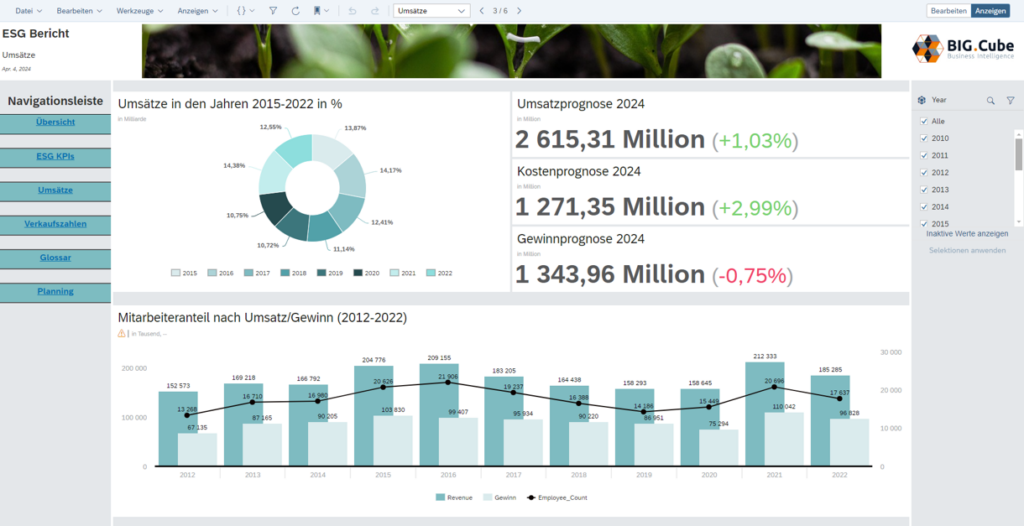
- In order to be able to fully utilise the self-service functionalities, support for the SAC designers on the part of IT is very important. A robust and detailed authorisation concept is also essential.
- For a live connection, knowledge of the data source is advisable. In addition, the underlying queries should be very high-performing, otherwise the building of the stories suffers.
- For many technical requirements, optimisation of the back-end (data mart layer) is necessary.
- In order to standardise reporting and layout, centrally specified templates are essential.
- With the help of technical documentation of models and data sources, end users can quickly build their own stories. In this way, you increase confidence in the solution.
- New functionalities and adjustments in the layout, which are made available by SAP on a quarterly basis, should be communicated to all users.
Embedded Analytics
For analytics close to the source of the data, Embedded Analytics is the right choice. Benefit from analytical and transactional data in one system and enjoy the advantages of a Clean Core:
- Configurable KPIs
- Role-based "overview pages" and cockpits
- Insight-to-action capability: analyse and solve
- Historical data for simulations and predictions
- Flexible drill-down for maximum transparency
- Optimisation of business processes in ERP through deep integration of operational analysis data
SAP BusinessObjects Business Intelligence
SAP BusinessObjects Business Intelligence refers to a suite that provides centralised data reporting, data visualisation and data exchange. It is operated on-premise as a BI layer for the SAP Platform Business Technology Platform and provides its users with decision-support information.
The suite promotes the independent data analysis of its users in self-service and thus increases decision-making in the company. At the same time, it reduces the effort in the IT area.
- The SAP BusinessObjects BI Suite as an integration of different tools for all requirements.
- Analyse Excel data easily and keep it consistent with SAP Analysis for Office.
- SAP Lumira for the optimal visualisation of your data.
- Mobile access from your smartphone at any time thanks to SAP BusinessObjects Mobile.
SAP Analytics
We are happy to support you in creating a sustainable solution with low maintenance costs. In doing so, we rely on the methodical application of SAP best practices and the SAP standard as well as our extensive experience.
